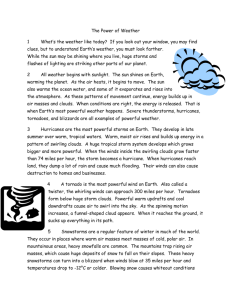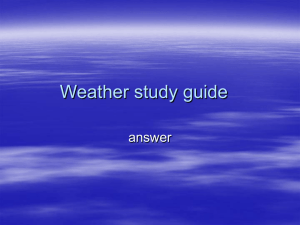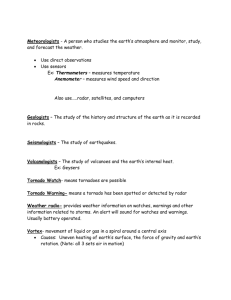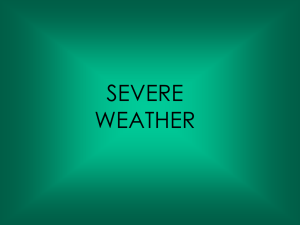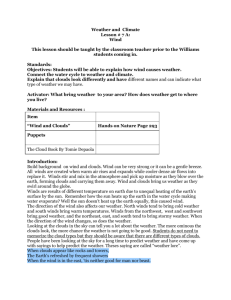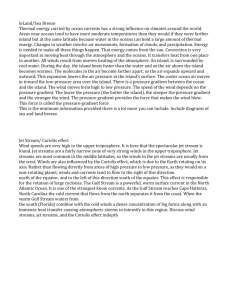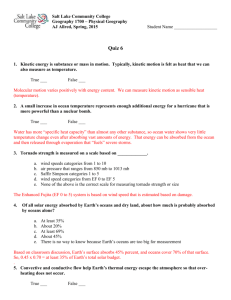Weather_Unit_Test_Practice_Key
advertisement
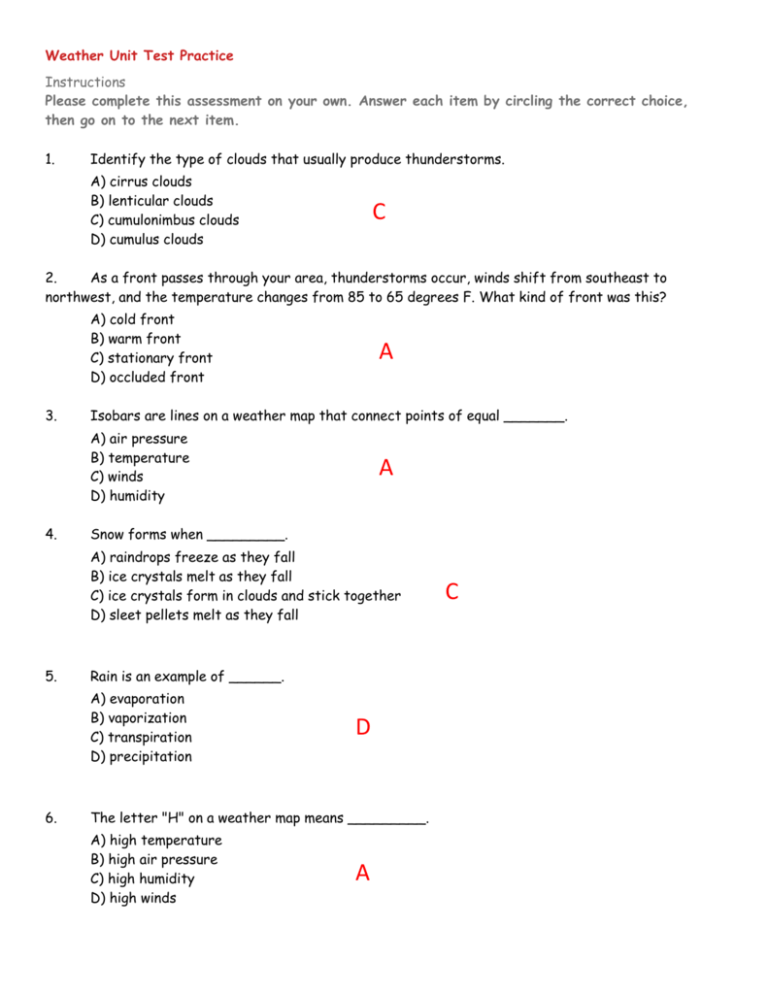
Weather Unit Test Practice Instructions Please complete this assessment on your own. Answer each item by circling the correct choice, then go on to the next item. 1. Identify the type of clouds that usually produce thunderstorms. A) cirrus clouds B) lenticular clouds C) cumulonimbus clouds D) cumulus clouds C 2. As a front passes through your area, thunderstorms occur, winds shift from southeast to northwest, and the temperature changes from 85 to 65 degrees F. What kind of front was this? A) cold front B) warm front C) stationary front D) occluded front 3. A Isobars are lines on a weather map that connect points of equal _______. A) air pressure B) temperature C) winds D) humidity 4. A Snow forms when _________. A) raindrops freeze as they fall B) ice crystals melt as they fall C) ice crystals form in clouds and stick together D) sleet pellets melt as they fall 5. Rain is an example of ______. A) evaporation B) vaporization C) transpiration D) precipitation 6. D The letter "H" on a weather map means _________. A) high temperature B) high air pressure C) high humidity D) high winds A C 7. What is the effect of the unequal heating of the Earth's surface? A) wind B) ocean tides C) the greenhouse effect D) the Coriolis effect 8. A What device is used to tell if the air pressure decreases during a storm? A) thermometer B) barometer C) anemometer D) hygrometer B 9. Bob and Ann want to know if today is warmer than yesterday. What scientific tool should they use to find out? A) hydrometer B) thermostat C) thermometer D) barometer 10. C When a mass of air is cooling, what will happen when the air temperature reaches the dew point? A) The skies will clear up. B) It will always start to rain or snow. C) Puddles of water will evaporate. D) Water vapor in the air will begin to condense. 11. What is the relative humidity when the air temperature is at the dew point? A) 0% B) 10% C) 50% D) 100% 12. D Low, gray, layered clouds that cover the sky and bring steady rain are: A) cumulus. B) cirrus. C) cumulonimbus. D) stratus. 13. D D Winds transfer energy in the atmosphere by the process of: A) convection. B) conduction. C) radiation. D) precipitation. A 14. What happens to the air pressure as you go higher in altitude? A) It increases. B) It decreases. C) It remains steady. D) It changes randomly. 15. Meteorologists refer to the water vapor in the atmosphere as _______. A) humidity B) precipitation C) condensation D) air pressure 16. B Evaporation and condensation are parts of which cycle? A) the energy cycle B) Earth's orbit C) the water cycle D) the life cycle 18. A When the dew point temperature is close to the air temperature, it means that: A) the air is very dry. B) the air is very humid. C) the air is very cold. D) it is very windy. 17. B C What would you expect to happen to the air pressure as a storm approaches? A) It would increase. B) It would decrease. C) It would remain steady. D) It would increase and decrease wildly. 19. What form of energy causes water to change from a liquid to a gas? A) heat B) sound C) waves D) light 20. B A If winds in a hurricane drop below 75 miles per hour, the hurricane is called _________. A) a tropical storm B) a typhoon C) a tornado D) an anticyclone A 21. Which of the following statements about tornadoes is NOT true? A) Tornadoes can be associated with thunderstorms. B) Tornadoes can have wind speeds over 150 miles per hour. C) Tornadoes never actually touch the ground. D) Tornadoes are common in hurricanes. 22. C Most tropical storms develop_________. A) in the polar regions B) over land C) over the ocean near the equator D) along the edges of tectonic plates C 23. A weather map is often used to illustrate the boundary that separates warmer and cooler air. What is this boundary called? A) a thermal line B) a conduction line C) the jet stream D) a front 24. D Most tropical depressions that form into hurricanes form: A) in late summer and early fall. B) in late spring and early summer. C) in late winter and early spring. D) in late fall and early winter. 25. An extended period with no precipitation is called: A) El Nino. B) a monsoon. C) a tropical depression. D) a drought. 26. D Most tornadoes form _________. A) along cold fronts B) along warm fronts C) in high pressure areas D) near the equator 27. A A What must happen for a tropical storm to be classified a hurricane? A) It must pass over land. B) Its winds must exceed 74 miles per hour. C) It must move eastward. D) Its winds must begin cooling. B 28. A tropical depression is an example of a: A) high pressure system. B) low pressure system. C) warm front. D) cold front. 29. B Where do hurricanes form? A) in the arctic region B) in the temperate regions C) close to the polar regions D) in the tropical regions 30. D How are wind storms related to temperature? A) Temperature differences cause differences in humidity. B) Temperature differences cause differences in air pressure. C) Wind storms only occur in very cold air. D) Wind storms only occur in very hot air. B 31. A fast approaching cold air mass is moving in to displace a warm moist air mass in the summertime. Which of these kinds of weather is most likely? A) a drought B) drizzling rain C) snow D) a thunderstorm 32. D Winds always blow _______. A) from sea to land B) from high to low elevations C) from low- pressure to high-pressure areas D) from high-pressure to low-pressure areas 33. Most of the time weather moves across the United States _________. A) from south to north B) from south to west C) from east to west D) from west to east 34. C D What kind of map would a meteorologist study? A) a weather map B) a map of space C) a geological map D) a topographic map A 35. In which layer of the atmosphere do most clouds form? A) troposphere B) They form in all layers. C) stratosphere D) mesosphere A Possible List/Fill In Questions: 1. What are the 6 factors that affect weather? 2. List the stages of hurricane development. 3. List 4 Basic Types of Clouds and the weather associated with each. 4. List 5 weather instruments and tell what weather factor each measures. Possible Essay Questions: 1. Compare and Contrast Hurricanes and Tornadoes as extreme weather events. 2. What is the most useful tool meteorologists can use to help predict weather? Why is this the most important? (Choose 1 tool and justify why it is most important with specific facts about its function. Your choice can’t be wrong as long as your supporting evidence is correct and convincing) 3. What are the six factors that affect weather on Earth and how do they interact to create weather?



